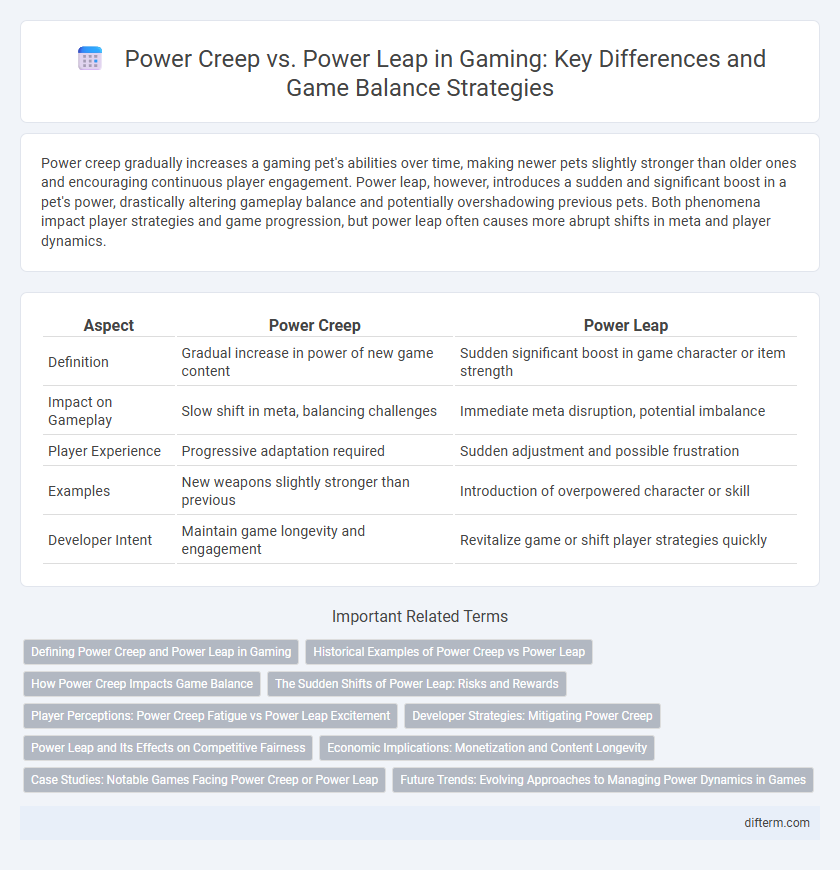Power creep gradually increases a gaming pet's abilities over time, making newer pets slightly stronger than older ones and encouraging continuous player engagement. Power leap, however, introduces a sudden and significant boost in a pet's power, drastically altering gameplay balance and potentially overshadowing previous pets. Both phenomena impact player strategies and game progression, but power leap often causes more abrupt shifts in meta and player dynamics.
Table of Comparison
| Aspect | Power Creep | Power Leap |
|---|---|---|
| Definition | Gradual increase in power of new game content | Sudden significant boost in game character or item strength |
| Impact on Gameplay | Slow shift in meta, balancing challenges | Immediate meta disruption, potential imbalance |
| Player Experience | Progressive adaptation required | Sudden adjustment and possible frustration |
| Examples | New weapons slightly stronger than previous | Introduction of overpowered character or skill |
| Developer Intent | Maintain game longevity and engagement | Revitalize game or shift player strategies quickly |
Defining Power Creep and Power Leap in Gaming
Power Creep in gaming refers to the gradual and continuous increase in character, weapon, or item strength over time, often resulting in older content becoming obsolete. Power Leap describes a sudden and significant boost in power, usually introduced through major updates or new expansions, drastically shifting the game's balance. Understanding these phenomena is essential for maintaining long-term game design and player engagement.
Historical Examples of Power Creep vs Power Leap
Power creep manifests in games like World of Warcraft, where successive expansions introduce increasingly stronger gear and abilities, gradually making earlier content obsolete. Power leap is evident in titles such as League of Legends, where periodically released champions possess significantly stronger kits, abruptly shifting the game's meta. Historical examples highlight that while power creep slowly elevates baseline power over time, power leaps cause sudden spikes in balance and competition dynamics within gaming communities.
How Power Creep Impacts Game Balance
Power creep gradually diminishes game balance by making older characters or items obsolete, forcing developers to continuously release stronger content to keep players engaged. This escalation leads to a homogenized meta where player choices narrow, diminishing strategic diversity. The resulting imbalance negatively affects player retention and competitive integrity, as newer players struggle to compete without the latest power upgrades.
The Sudden Shifts of Power Leap: Risks and Rewards
Power Leap causes sudden and significant increases in character or item strength, often disrupting game balance and challenging existing meta strategies. This rapid escalation can generate excitement and renewed player interest but risks alienating veterans who must adapt quickly or face obsolescence. Developers must carefully manage these shifts to maintain competitive fairness while leveraging Power Leap events to boost engagement and game longevity.
Player Perceptions: Power Creep Fatigue vs Power Leap Excitement
Players often experience fatigue with power creep when new updates gradually introduce stronger abilities that overshadow older ones, leading to a sense of imbalance and diminished value of existing gear. In contrast, power leaps generate excitement by delivering sudden, significant boosts in power that refresh the gameplay experience and encourage strategic adaptation. This dynamic influences player retention, as sustained power creep can cause disengagement, while well-executed power leaps reenergize player communities and spark renewed interest.
Developer Strategies: Mitigating Power Creep
Game developers mitigate power creep by implementing balanced patch updates that gradually adjust character abilities and equipment stats, ensuring no new content overwhelmingly outshines existing options. Introducing power leaps through limited-time events or seasonal content allows temporary boosts without permanently disrupting game balance. Employing player feedback analytics and rigorous playtesting enables fine-tuning of progression curves to maintain competitive fairness and long-term engagement.
Power Leap and Its Effects on Competitive Fairness
Power Leap in gaming occurs when new abilities or items significantly outclass existing ones, disrupting the balance and diminishing the value of earlier progress. This sudden surge can alienate veteran players while forcing others to constantly adapt, undermining competitive fairness. Maintaining a stable power curve is essential to preserving skill-based competition and player retention.
Economic Implications: Monetization and Content Longevity
Power creep in gaming drives continuous monetization by encouraging players to invest in increasingly powerful gear or abilities, often leading to short-term revenue spikes but potentially reducing content longevity as older items become obsolete. Power leap, involving significant but less frequent power shifts, can reinvigorate player interest and stimulate spending by introducing fresh, high-impact content without rendering previous investments worthless. Balancing power creep and power leap is crucial for sustaining a stable in-game economy, maximizing lifetime player value, and preserving engagement across long-term content cycles.
Case Studies: Notable Games Facing Power Creep or Power Leap
Games like World of Warcraft and Marvel's Contest of Champions highlight the challenges of power creep, where successive expansions or updates continuously raise character strength, disrupting game balance and player experience. Conversely, titles such as Dark Souls exhibit a power leap phenomenon, introducing significant shifts in gameplay mechanics or character abilities that redefine player strategies and meta. These case studies demonstrate the delicate balance developers must maintain to preserve competitive integrity while evolving their games.
Future Trends: Evolving Approaches to Managing Power Dynamics in Games
Future trends in gaming indicate a shift from traditional power creep toward more dynamic power leap mechanics, allowing for sudden, significant boosts that reshape gameplay balance. Developers are increasingly implementing adaptive scaling and modular upgrade systems to manage power dynamics, ensuring prolonged player engagement without diminishing earlier content. Advanced analytics and player feedback integration are driving these evolving approaches, fostering competitive environments that remain fresh and challenging.
Power Creep vs Power Leap Infographic

 difterm.com
difterm.com